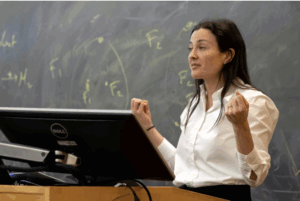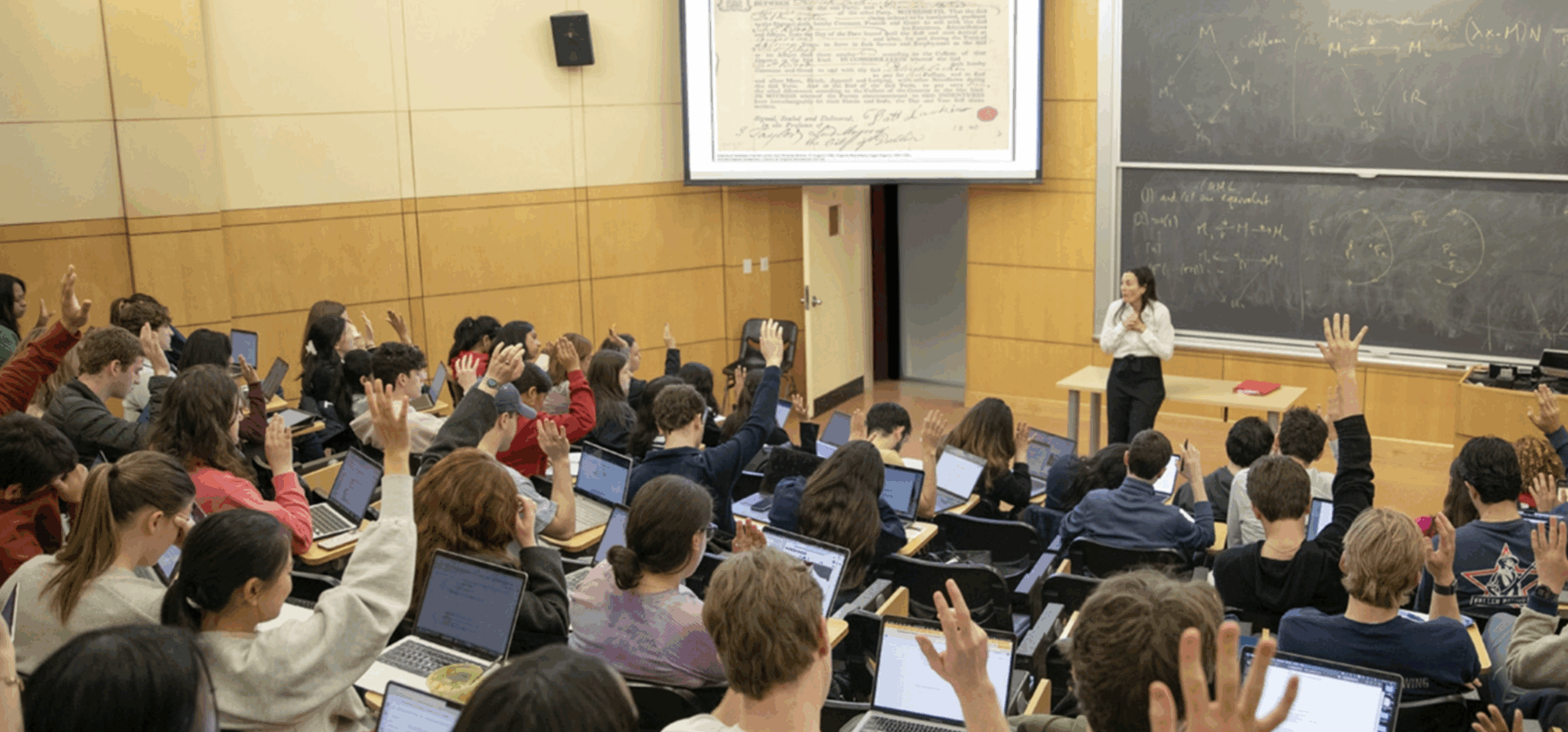“To have a functioning republic, you need citizens getting education,” says Assistant Professor of History Sarah Gronningsater, from a podium in David Rittenhouse Laboratory. Classrooms in this building are usually reserved for introductory math, physics, and astronomy courses, but this one happened to be the only room big enough to accommodate Gronningsater’s 150 history students (plus a couple of student auditors).
Behind her, equations from someone else’s lecture are chalked on the double-hung blackboards, but no matter—she has slides and her students’ attention, flipping between bullet-pointed text, movie clips, and images of paintings and original documents during Hamilton’s America, a Stavros Niarchos Foundation (SNF) Paideia course that illustrates the political, constitutional, and social history of colonial America and the United States from 1754 to 1804.
The class outlines the nascent U.S. republic, beginning with the Seven Year War and running through Thomas Jefferson’s heated ascent to the presidency, an election he won against incumbent John Adams—a Federalist embroiled in a rocky stand-off with Alexander Hamilton. Hamilton’s America is not a biographical course of the influential U.S. statesman, though. Instead, the titular character serves as a lodestar, as well as a familiar reference for a generation of students who grew up with the Lin-Manuel Miranda musical.
Over the course of a semester, Gronningsater introduces both familiar and unfamiliar topics—the Revolutionary War, the creation of the U.S. Constitution, slavery and antislavery, Native American power and loss, religious awakenings, the history of Haitian independence, and the rise of partisan politics. To punctuate lectures, she shows movie excerpts and song clips—one student even brings her own mic to class to sing along.

This past semester was the third time Gronningsater has taught the course since the spring of 2020, during a pandemic pivot to online learning. Since then, her class size has tripled and the course became part of the SNF Paideia program, incorporating optional small-group sessions that focus on selected readings—constitutional law, for example—and featuring experts across the University. Gronningsater also holds one attendance-optional “flex day” per semester, a “cocktail party without cocktails,” with snacks and conversation. Every year, more than half the class shows up, a testament to how they feel about the class community, she says.
That’s especially poignant now, she adds, in a time of heightened political rhetoric, and as the country nears the 250th anniversary of the signing of the Declaration of Independence. Gronningsater believes in the study of history, and she’s keeping the faith: “If I teach the history on its own terms, in its own moment, with its own lessons in its own past context, inevitably the students will be able to understand their present world in new ways,” she says. “Because, by definition, we live in the world that the past made.”
Educating Citizens
During one class in April, Gronningsater outlines the Founding Fathers’ visions for public education, detailing the differences between Alexander Hamilton’s nationalizing vision—Harvard, Yale, and Columbia were “hotbeds of Federalists,” she notes—and Thomas Jefferson’s desire to promote more local governance and individual liberty, leading to his establishment of the University of Virginia in 1819.
“Every government degenerates when trusted to the rulers,” Jefferson wrote in Notes on Virginia in 1782. “The people themselves, therefore, are its only safe depositories. And to render even them safe, their minds must be improved to a certain degree.”
It was a sentiment Jefferson evoked often in the nearly four decades to follow, in letters to contemporaries Littleton Waller Tazewell (1805), William Duane (1810), and William C. Jarvis (1820), especially after purchasing a polygraph machine in 1804, which he used to make copies of the letters he sent while “drudging at the writing table,” as he called it. For Jefferson, the idea that the American people are the “safe depositories” of liberty, power, and enlightenment hinged on the promise and power of education, an idea that Gronningsater posits to her students now.
She’s engaged in her own American experiment.
“Republics thrive when people come together in public for the common good,” Gronningsater says. In her republic, bi-weekly lecture attendance is mandatory. And as a democratic republic, participation is expected. Students ask and answer questions throughout lecture; they also debate the complex political, constitutional, and ethical questions raised by the course material.
If I teach the history on its own terms, in its own moment, with its own lessons in its own past context, inevitably the students will be able to understand their present world in new ways. Because, by definition, we live in the world that the past made.
By design, the syllabus brings in a “cacophony of voices,” Gronningsater says, pulling in high politics and famous names along with the motives and tribulations of everyday people: their desires, their debts, their deaths. “Part of history is to put all these voices and agendas together over the course of a semester so we can understand what happened and why,” she says. “We also talk about how historians document the politics and lives of people who couldn’t write, which was a lot of people in early America, including slaves, servants, the poor, young children. But they are fundamentally important to the story.”
Gronningsater expects students to take on these voices, to set forth the positions of Adams or Hamilton or Jefferson, along with speculators and bond-holding servicemen and Native American diplomats. “Pedagogically, I hope to create an environment where I am playing devil’s advocate and asking students to play devil’s advocate,” she says. “Can you imagine how people in the moment disagreed? Take on the position and argue the point. Why might two slaves in different regions make opposite choices in terms of which side to join in the Revolution? What does a Quaker pacifist have to navigate?”
As a social historian, Gronningsater also brings in a humanistic view. “We talk about the Founding Fathers, but we also talk about the people who washed their dishes,” says Arshiya Pant, C’27. And Gronningsater paints those who founded this country as humans, not as infallible icons, demonstrating this through personal correspondence, for example between John and Abigail Adams.
“‘My dearest friend, I am so anxious for your health,’” reads Gronningsater from Abigail’s 1793 letter to her husband in Europe. “They still love each other very much,” Gronningsater tells the class, as they linger over a still of the long-married pair from the 2008 John Adams miniseries.
“I am weary of reading Newspapers,” Adams replies to his wife. “The Times are so full of Events, the whole Drama of the World is such a Tragedy that I am weary of the Spectacle. Oh my Sweet little farm, what I would not give to enjoy thee without interruption?”
Sometimes, Gronningsater says, she is weary, and teaching the class provides a respite. “On Tuesdays and Thursdays, this course is like my shining sun.”
“A Big Tent”
This is the second class Tomas Jasson, C’27, is taking with Gronningsater. Jasson, who is from Greenwich, Connecticut, and majoring in history and philosophy, politics, and economics, says the biggest challenge is always “holding yourself accountable,” and that if you “sit passively in lectures and don’t prepare—then you’re selling yourself short.” From “day one,” he adds, Gronningsater has this “ability to create interpersonal connections from the front of a lecture hall.”
Pant, who is from Kansas City, Missouri, and is majoring in history and law and societies, transferred to Penn this year. She says the class made her feel more connected to the University as a whole. “Everyone is bringing something interesting to the table,” she says. “Your answer is always welcome, and it’s never unproductive. You know that what you say has a place in a conversation. And not just a good-feeling sort of way, but genuinely.”
The whole point, Gronningsater says, is that just like America, this class “has to be a big tent.” And there’s a huge demand for it, among American as well as international students, she says. Gronningsater has been teaching this course over a five-year period that’s often described as “unprecedented.” But so was America’s founding, she says.
“The American Revolutionary period itself was a time of intense change, intense uncertainty. People didn’t know what the next year was going to be like. And coincidentally, the period of the American Revolution was also a time of epidemic disease,” she says, citing smallpox and yellow fever. “It allows me to present the history of the American Revolution and the early republic as the contingent and frightening and fractious—and at times inspiring, at times depressing—historical moment that it was.”
That approach can make students reassess what they thought they knew about history. Jasson, for example, had always been sympathetic to Hamilton and the Federalists. To him, the idea of a national bank seemed obvious. But in the readings and discussions from class, he learned more about Madison and Jefferson’s opposition. “I was going in with a 21st-century mindset, instead of looking at it as someone in that moment and understanding the gravity of, say, making the decision to federalize debt, or making the decision to create a national bank.”
For Pant, studying history in this way has shifted how she sees the world, has helped her understand her opinions and how she fits in. “There’s a sense of belonging,” says Pant, whose parents are both Nepali immigrants. “You understand that there are many parts.” American history is riddled with both shining examples and embarrassments, she adds, but “there’s so much power in deep understanding and compassion, whether for a person or an institution.” Pant wants to pursue this compassionate understanding forever, she says. “Being in a class like this, being a history student, gives me access.”
The Next Generation
“History gives us a great perspective,” says Jasson. “Right now, it looks like we’re in a tough spot, which we are. But you look at the election of 1800 or the Democratic Republicans and Federalists at each other’s throats … we’ve had these problems and these crises before. We’ve survived them.”
Jasson is Argentine on his father’s side, Spanish on his mother’s. As a first-generation American, “I drank the Kool-Aid a little bit,” he says, speaking about his view on the opportunities and education that the U.S. offers. “I do believe we have something special,” he adds. “It’s something worth fighting for and passing on to the next generation.”
Gronningsater herself notes that “the past is a foreign country, in many ways,” but that it was still populated by people not so different than the ones sitting at desks in David Rittenhouse Laboratory. “I would hope our generation really cares about having a strong country where people can get along,” Jasson says. It’s possible, he adds, as long as “we don’t let what separates us define us.”
“The humanities are about being interested in humans, and what they do, and why,” says Gronningsater. “And ideally, about loving humanity.”
America may have been born on the battlefield. But American ideals were forged in small rooms like the one shared in Hamilton’s America, where high ideals bandied about with high tempers. Gronningsater wants her students to envision colonial America populated with people advocating for their interests, finding partners and jobs, sometimes stopping by the tavern for beer and banter after a long day at work—a past world similar and yet vastly different from the everyday lives of college students.
She says she hopes the course gets them to think about how effective these people were in winning arguments during the days of the early republic, and how, in a democracy, someone might persuade fence-sitters to their side. What if rights are unequally distributed? How do democracies change? What is freedom? How do republics confront evil? These questions are centuries-old, Gronningsater says. And yet studying them helps students to navigate their own complexities, she says.
And in this history class, it’s all part of the curriculum. The people, as Jefferson said, are and always have been the safest repository of their own political freedoms.

